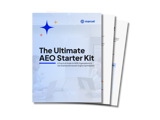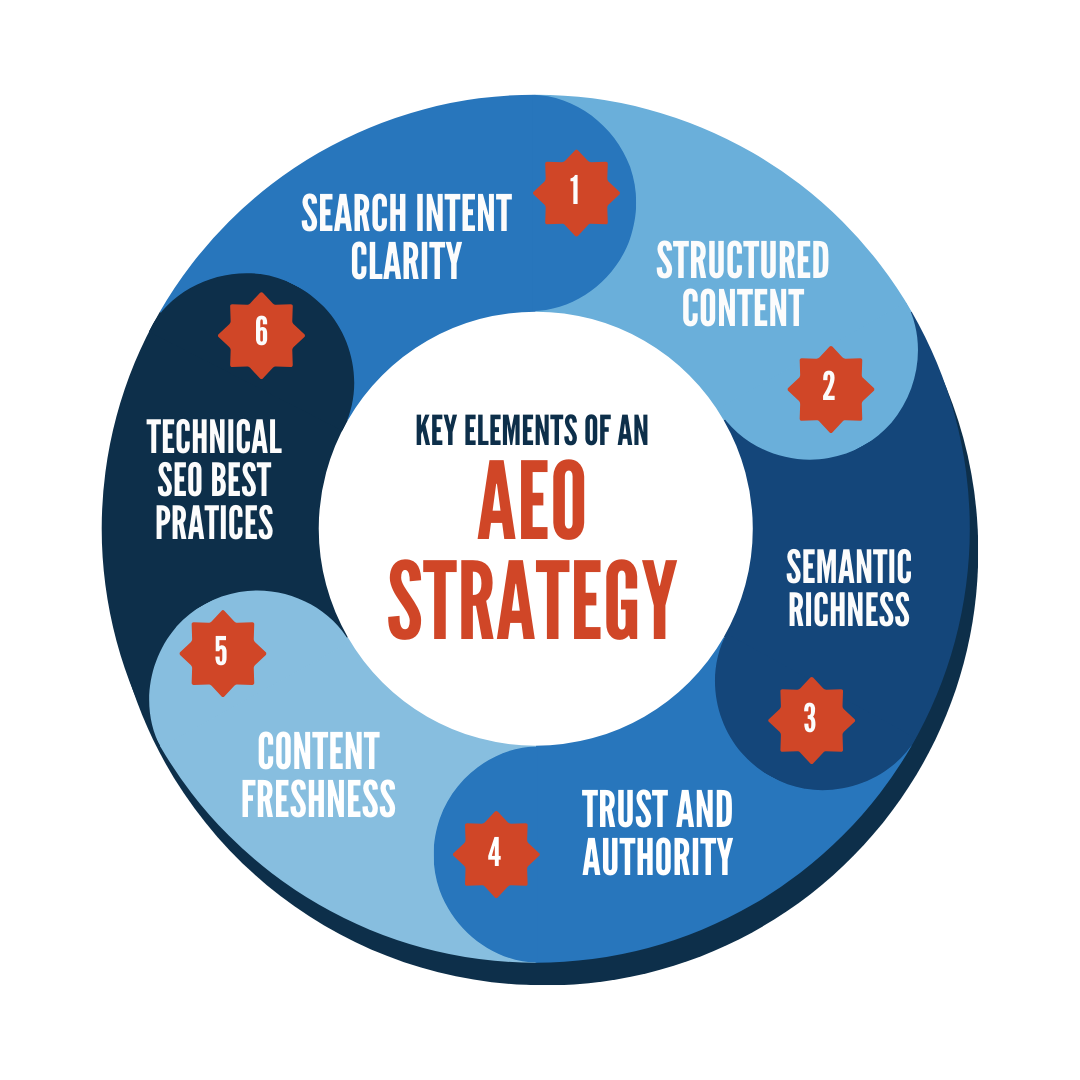The way people search is changing.
Instead of scrolling through a list of search results, users are turning to AI-powered tools like Perplexity AI, Bing Copilot, and ChatGPT with browsing capabilities to get direct, concise answers. Often, these answers include cited sources. This shift in behavior is giving rise to a new type of strategy: Answer Engine Optimization (AEO).
What Is Answer Engine Optimization?
Answer Engine Optimization (AEO) is the process of structuring and optimizing content so that it can be easily interpreted and cited by AI-powered answer engines. These tools don’t show a list of ranked websites. Instead, they deliver conversational, synthesized answers and include links to the sources they pull from.
Unlike traditional SEO, which focuses on organic ranking positions in a search engine results page (SERP), AEO focuses on earning citations or being quoted directly in AI-generated responses.
These answer engines are becoming primary discovery tools for:
- Professionals researching solutions
- Consumers comparing products or services
- Students and educators seeking reliable source
- Decision-makers looking for fast, trustworthy summaries
To succeed in this space, your content needs to go beyond keywords. It needs to provide clear, complete, and authoritative answers.
How Answer Engines Work
Answer engines like Perplexity AI and Bing Copilot work by combining natural language processing (NLP) and large language models (LLMs) to understand user queries, then generate a coherent, contextually rich response. But they don’t just guess. They draw from real online content, including blog posts, whitepapers, news articles, product pages, and more.
Here’s how they operate:
- They interpret user intent from full-sentence, often conversational queries.
- They search the web or a database of indexed content for credible answers.
- They summarize and synthesize the content into a human-like response.
- They often cite the sources they pulled from. This is your AEO opportunity.
If your content is clear, structured, and trustworthy, these tools are more likely to surface and cite it.
Why AEO Matters
AI-powered tools like Perplexity AI, Bing Copilot, and ChatGPT are redefining how users search for and discover information. Instead of navigating traditional search engine results pages (SERPs), users are increasingly turning to these platforms to ask full, natural-language questions and receive direct, synthesized answers. These responses often include source citations, creating a new type of discovery experience - one where being the cited source can lead to real traffic and real conversions.
This shift has major implications for content marketers, SEO strategists, and digital teams. It’s no longer just about ranking on Google. It’s about being referenced by AI tools that people trust to summarize the web for them.
Here’s why Answer Engine Optimization (AEO) is becoming essential to modern digital strategy:
Brand Visibility Where It Counts
When your content is cited in an answer engine response, it appears within the primary source users are reading - not buried in a list of 10 blue links. This kind of visibility is more direct and often more influential, especially for top-of-funnel queries where trust and awareness are key.
Referral Traffic That Converts
One of the biggest misconceptions is that citations in AI-generated answers don’t lead to clicks. In reality, many of these platforms—including Perplexity and Bing Copilot—link directly to the original source, allowing users to click through for more information.
Even better: the users coming through these channels are often high-intent. They’ve already read a summarized version of your content. If they choose to visit your site, it’s because they want to go deeper, making them more qualified than the average search visitor.
Early adopters of AEO are already seeing referral traffic from Perplexity.ai and similar tools show up in analytics platforms. These visits often lead to:
- Time-on-page metrics that outperform traditional search
- Lower bounce rates
- Higher conversion intent (e.g., demo requests, content downloads, purchases)
As tracking evolves and attribution catches up, expect AI engine referral sources to become a growing and measurable part of your digital funnel.
Authority and Trust at Scale
When Perplexity AI or another answer engine cites your site, it functions as a third-party endorsement of your credibility. The AI has essentially vetted your content and chosen it as a reliable answer.
That perceived trust translates into real-world benefits:
- Improved brand reputation
- Increased user confidence
- Higher conversion likelihood when users land on your page
It’s digital word-of-mouth - at scale.
A Competitive Edge in an Untapped Channel
Most brands are still focused exclusively on Google rankings and traditional SERP visibility. Few are actively optimizing for answer engines. That gives your business a first-mover advantage in a channel that’s growing fast but still underdeveloped.
By investing in AEO now, you can position your content ahead of competitors in AI-generated summaries—and begin capturing traffic they don’t even know they’re missing.
Future-Proofing Your Digital Strategy
The nature of search is changing. We’re moving from keyword inputs to conversational queries, and from click-based browsing to answer-based consumption.
AEO is how your business stays relevant in this new landscape. It’s how you ensure your content surfaces when - and where - it matters most.
The Ultimate AEO Starter Kit
Download our free AEO (Answer Engine Optimization) kit and learn how to make your business the answer in AI-driven search.

Key Elements of an AEO Strategy
To earn citations in answer engines, your content needs to be useful to both humans and AI models. That means blending SEO best practices with content clarity, structure, and contextual relevance.
Below are the core elements of an effective AEO strategy:
1. Search Intent Clarity
At the heart of AEO is understanding what users are really asking—and answering it clearly. This goes beyond targeting keywords and focuses on crafting direct, intent-matching responses.
Instead of writing a post titled “AEO Tips,” consider framing it around the actual question your audience is searching like “What is Answer Engine Optimization and how does it work?”
Then, answer that question in the first few sentences of your content. Clear, concise responses are more likely to be extracted and cited.
2. Structured Content
AI models favor content that is well-organized and easy to interpret. That means:
- Using descriptive headings (H2s and H3s) to break up content
- Incorporating bullet points, tables, and numbered lists
- Keeping paragraphs short and readable
This kind of formatting not only improves user experience—it increases the chances that an answer engine will identify and cite the relevant section of your page.
3. Semantic Richness
Answer engines work with language models trained to understand relationships between concepts. That means your content should:
- Use related terminology and synonyms
- Include contextual explanations around key terms
- Address common follow-up questions users might ask
Rather than repeating the same keyword, cover the full scope of a topic. This helps AI models understand that your content provides a comprehensive answer.
4. Trust and Authority
AI engines prioritize high-quality sources, and that often comes down to credibility signals within your content:
- Link to authoritative, external sources (e.g., academic research, government data, industry reports)
- Include author bylines with relevant credentials
- Use clean, editorial tone with accurate spelling and grammar
In essence, write like an expert and support your claims. That’s what answer engines are looking for when choosing what to cite.
5. Content Freshness
Relevance is key. AI engines often favor content that reflects the most up-to-date information - especially in industries like tech, health, and finance.
Make it a habit to:
- Update older blog posts with current data and examples
- Refresh stats, references, and links regularly
- Republish evergreen content with new insights
Search engines reward freshness, and so do answer engines.
6. Technical SEO Best Practices
While AEO is focused on content quality, your technical foundation still matters. Make sure your site is:
- Crawlable and free of major errors (use Google Search Console to monitor)
- Fast-loading and mobile-friendly
- Enhanced with schema markup, especially for FAQs, how-to guides, and definitions
These signals help AI and search bots accurately index and parse your content - making it more likely to appear in both SERPs and AI-generated answers.

Practical Steps to Implement AEO
If you're looking to get started with AEO today, here’s a step-by-step approach you can use.
Identify the Right Questions
Start with tools like AnswerThePublic, AlsoAsked, and even Perplexity AI itself to find common, high-intent questions your audience is asking. Look for question formats like “how,” “what,” “why,” or “best way to...”
Optimize Existing Content
Take your top-performing blog posts or product pages and restructure them to include:
- Clear answers near the top
- FAQ sections addressing related queries
- Subheadings that mirror search phrasing
Write with AI in Mind
Create content that is informative, neutral, and clear. Avoid jargon and fluff. Use natural language, and make sure each piece of content fully answers a specific question.
Monitor Citations and Mentions
Regularly search your own brand or key topics on platforms like Perplexity AI to see if you’re being cited. If not, analyze which sources are and adjust your approach.
Update Frequently
Keep your content fresh by revisiting it regularly. Update data, examples, screenshots, or links, and look for new questions to answer.
Tools to Support AEO
Here are a few tools that can help you research, write, and measure your AEO strategy:
- AnswerThePublic: Discover long-tail, question-based queries.
- Perplexity.ai: Test queries and monitor what content gets cited.
- ChatGPT (with browsing): Simulate answer engine behavior for your content.
- Surfer SEO / Clearscope: Ensure semantic relevance and topical depth.
- Google Search Console: Track impressions and performance for question-focused content.
Bonus: Use these tools together. For example, research with AnswerThePublic, write with Surfer SEO, and test responses in Perplexity.

AEO and the Future of Content Strategy
The rise of answer engines signals a deeper shift in digital behavior. People want information, not just options.
This evolution calls for a new mindset in content strategy. One that prioritizes:
- Helpfulness over hierarchy
- Answers over ads
- Credibility over clickbait
If your business creates content that’s designed to serve the user first, you’ll naturally align with how AI systems evaluate and elevate information. AEO is about anticipating what your audience needs and becoming the most reliable, structured source for it.
Marcel Digital’s Approach to AEO
At Marcel Digital, we understand that digital visibility is no longer just about ranking. It’s about relevance, authority, and usability across every channel where your audience searches.
Our approach to AEO includes:
- In-depth query and intent research
- Content audits with answer engine readiness in mind
- Structured content development optimized for citations
- Continuous performance monitoring across traditional and AI-driven platforms
We help businesses build content strategies that thrive, whether on Google, Perplexity, or wherever search goes next.
Partner with Marcel Digital to Lead in Answer Engine Optimization
As AI-powered tools reshape how people search, your content needs to do more than rank. It needs to be answered.
Partner with Marcel Digital to build an AEO strategy that earns citations, establishes authority, and prepares your business for the future of search. From intent-driven content development to technical optimization, our team is ready to help you lead where your audience is headed.
Let’s make your content the answer. Contact us today to get started.
SEO
About the author
Joe Stoffel
Joe knows what it takes to drive SEO results. He is an experienced SEO specialist who currently leads the SEO department and strategy at Marcel Digital.